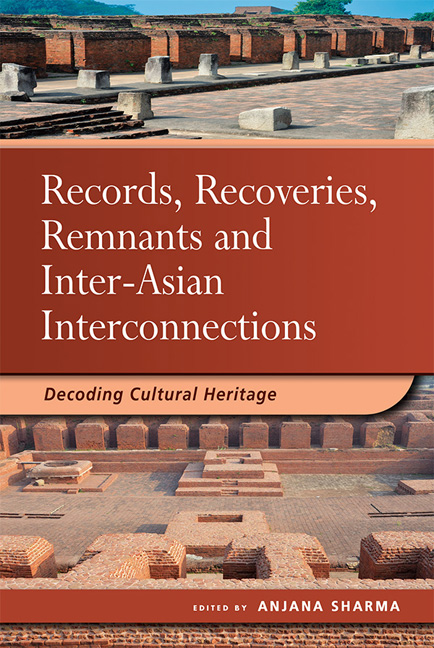Book contents
- Frontmatter
- Dedication
- Contents
- Contributors
- Acknowledgements
- 1 Introduction: Records, Recoveries, Remnants and Inter-Asian Interconnections — Decoding Cultural Heritage
- 2 Negotiating Place and Heritage: Creating Nalanda University
- 3 India, Magadha, Nalanda: Ecology and a Premodern World System
- 4 Collecting the Region: Configuring Bihar in the Space of Museums
- 5 Heritage Preservation in the Gaya Region
- 6 Setting the “Records” Straight: Textual Sources on Nālandā and Their Historical Value
- 7 “Central India Is What Is Called the Middle Kingdom”
- 8 The Object | The Tree: Emissaries of Buddhist Ground
- 9 Tracing Transregional Networks and Connections Across the Indic Manuscript Cultures of Nusantara (AD 1400–1600)
- 10 Seeking a Sufi Heritage in the Deccan
- 11 Archaeological Remains at Nalanda: A Spatial Comparison of Nineteenth Century Observations and the Protected World Heritage Site
- 12 A Heritage Gem Sits in the Heart of a City, Unacknowledged, Incognito: The Case for Recognizing Kolkata Chinatown as a Historic Urban Landscape
- Index
- Miscellaneous Endmatter
1 - Introduction: Records, Recoveries, Remnants and Inter-Asian Interconnections — Decoding Cultural Heritage
Published online by Cambridge University Press: 04 July 2018
- Frontmatter
- Dedication
- Contents
- Contributors
- Acknowledgements
- 1 Introduction: Records, Recoveries, Remnants and Inter-Asian Interconnections — Decoding Cultural Heritage
- 2 Negotiating Place and Heritage: Creating Nalanda University
- 3 India, Magadha, Nalanda: Ecology and a Premodern World System
- 4 Collecting the Region: Configuring Bihar in the Space of Museums
- 5 Heritage Preservation in the Gaya Region
- 6 Setting the “Records” Straight: Textual Sources on Nālandā and Their Historical Value
- 7 “Central India Is What Is Called the Middle Kingdom”
- 8 The Object | The Tree: Emissaries of Buddhist Ground
- 9 Tracing Transregional Networks and Connections Across the Indic Manuscript Cultures of Nusantara (AD 1400–1600)
- 10 Seeking a Sufi Heritage in the Deccan
- 11 Archaeological Remains at Nalanda: A Spatial Comparison of Nineteenth Century Observations and the Protected World Heritage Site
- 12 A Heritage Gem Sits in the Heart of a City, Unacknowledged, Incognito: The Case for Recognizing Kolkata Chinatown as a Historic Urban Landscape
- Index
- Miscellaneous Endmatter
Summary
I met a traveller from an antique land
Who said: Two vast and trunkless legs of stone
Stand in the desert. Near them on the sand,
Half sunk, a shatter'd visage lies, whose frown
And wrinkled lip and sneer of cold command
Tell that its sculptor well those passions read
Which yet survive, stamp'd on these lifeless things…
Percy Bysshe Shelley, Ozymandias, 1818So why begin an introduction on the contours, memories and cascading narratives of an inter Asian cultural history and heritage making with the sonorous words of the quintessential British Romantic poet, Percy Shelley, writing of a lost and unknown king, one who is possibly an Egyptian tyrant in an ancient time? A poem which takes at its point of entry the view of “a traveller from an antique land”, one, it is clear, who has no direct links with this land but is encountering an unknown, unreadable culture and is seeking to decipher and decode the lost civilizational history from a Eurocentric, colonially shaped imaginary.
So is it a sense of historical myopia and twisted irony, to choose as an epigraph this iconic poem, one that is symbolic in literary history of the opaqueness of cultural encounters? More so given that many essays within the pages of this volume directly disagree and debate on how history is manifested, absorbed and then concretized into a narrative that feeds a culture's — any culture's — sense of hegemony: accounts that have the common seam of being dialogic and interrogative, and, fundamentally, anti-colonial.
However, the views that emerged in the works of a Shelley, or others I will cite/site later on in this introduction, sit well with the arc of the narrative that many of the cultural theorists, Sinologists, historians, art historians, interlocutors of heritage and culture, its practitioners, religious study experts and social anthropologist engage with in this collection. At the heart of these contestations lie the vexed questions of cultural heritage, its complex and multivalent legacies, its deep fissures, its ruptures indicative of ideological schismatics and political shifts, its historical reconfigurations and altered meanings and symbolic “value” across time. In fact, as we read through this collection, we find that the drum beat of a lost time echoes in different ideational registers till today.
- Type
- Chapter
- Information
- Records, Recoveries, Remnants and Inter-Asian InterconnectionsDecoding Cultural Heritage, pp. 1 - 31Publisher: ISEAS–Yusof Ishak InstitutePrint publication year: 2018



